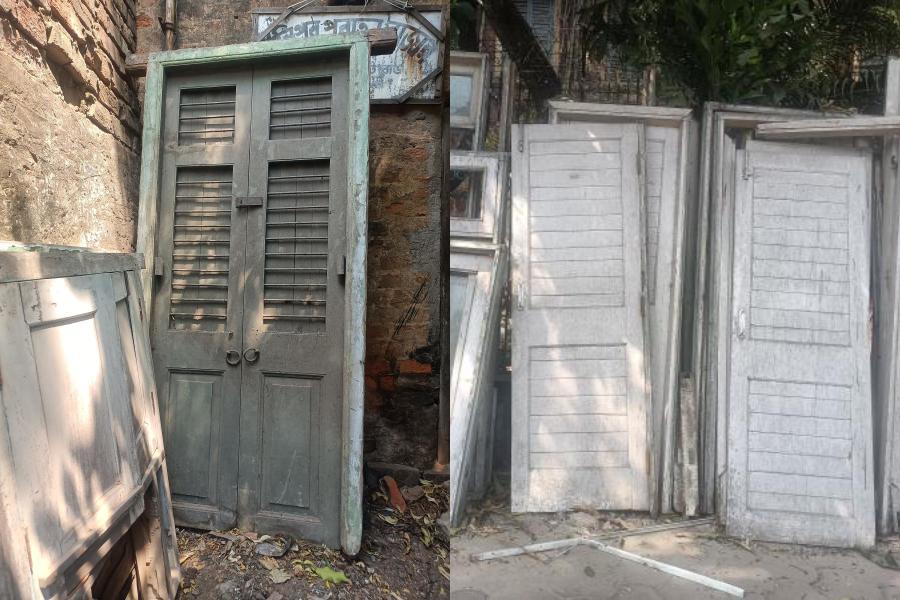Agreen door upside down. Another one with carved panels. Yet another with an arched top. Doors with nameplates still attached to them. Louvred windows. Solid wood windows. Painted. Washed out. Windows fitted with grills.
Across Calcutta, there are many stretches where you will see such scenes. Alipore’s Puratan Bazar, which is off Old Judges Court Road in south Calcutta; near Kidderpore dock; in Gopalnagar which lies beyond Chetla.
In this city of ours, every other day old houses are pulled down and turned into flats and apartment blocks. Subir Mazumdar, who is a promoter-cum-developer working in the Mukundapur area, says, “Whenever we buy an old structure, we are left with a whole lot of old woodwork. It is nothing more than garbage to us. We have to discard them. So we sell the bricks to someone, the rubbish to another, and the wooden doors and windows invariably to the kabadi-wala.” Those in the know say that the bricks of the State Bank of India building in central Calcutta’s Strand Road have been used for the facade of “heritage retreat” Ffort Raichak.
The upside down door is from a house in Chetla. Raju, the kabadiwala, bought it along with two other doors and two windows. A giant of a door with a gap on top. Nilina Deb Lal, heritage consultant and researcher, listens to the description and says, “While the solid wood kept the heat out, the glass fixed on top let the light in. In the 18th century, coloured glass was used by the affluent.”
Yet another door. This one still has the lock hanging from it. This one once came attached to a house in Kalighat. “It is made of teak,” says the shopkeeper at Gopalnagar. “One old woman used to live there but now she is no more. The children have sold the property,” he adds.
Of course, once procured, these doors and windows cannot be used as they are. Someone has to fix them, give them a coat of paint or polish. In the patch close to Kidderpore Dock, some old doors and windows are being fixed. “A customer wanted half a dozen such windows,” says Mustaq, who is the shop owner.
Some of the customers want the wooden frames but not the doors. A shopkeeper on Bondel Road was asked to fix fibre sheets or plywood onto the wooden frames.
Babu Mondal, who owns a furniture shop near Chetla railway station, says, “I bought this door for ₹300. It is not antique but it is sturdy wood. It is not broken but wobbly. I will spend about ₹500 to repair it, polish it, and then I shall sell it for ₹2,000.”
But some other doors are lying on the footpath. “They cannot be mended,” says Babu. He continues, “But they have their uses. It is wood after all. It can be used for designing new furniture. We use the frames of doors to make ladders. A single long piece of wood is quite expensive.” A shopkeeper in Kidderpore adds, “If it is much too rotten, it can still be burnt for fuel.”
And who might these customers be? “Phillum sets,” says Raju. A set designer from Tollywood who does not want to be named says, “Rituparno Ghosh would rent old furniture for his movies. And now, many directors use old doors and windows when they want to create the feel of a certain period. It is cheaper than renting a building.”
Then come the architects. Neeta Das is a Calcutta-based conservation architect. As a conservationist, she uses old doors for refurbishing and restoring old houses. She says, “Solid doors made of Burma teak are in demand. When restoring a building, I look for these. If they match the size, I use them.”
Slum dwellers form another category of buyers. Many buy broken louvred windows as they think air will flow in from the gaps in the window, says shopkeeper Ramanuj. Others buy them only to improvise and use them like pieces of furniture.
And then, of course, there are the collectors. Pradip Das, who is an artist, went searching for louvred windows when he was doing up his studio Chander Pahaar in Behala. He says, “I wanted to give the studio a different look. I bought a couple of louvred windows from a kabadiwala in Bowbazar. The rest I got designed by my carpenter; I could not find more of the same design.” These windows, he says, allow sufficient air and light which is important for a studio as a lot of things are stacked inside.
Not all collectors have to plough through pavement shops though. In the 1990s when the British High Commission was pulled down, G.M. Kapur of Intach procured the front door for his own house; a grand Burma teak structure, half glass and half wood, and two side panels. He says, “In the 1960s, Queen Elizabeth II had entered through that door. Imagine!”











